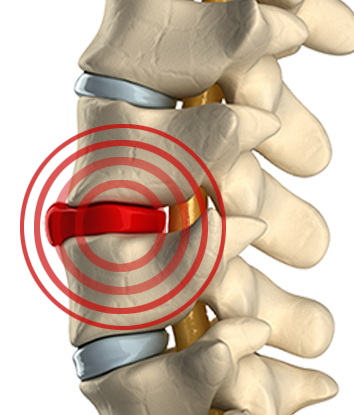Conditions
HERNIATED DISC

A Painful Condition That Can Be Treated Without Surgery
A herniated disc, also known as a slipped or bulging disc can appear anywhere on your spine. Usually, it occurs on your neck, (cervical spine) or lower back (lumbar spine), usually causing “a pinched nerve.”
If you are experiencing pain or numbness in your neck, low back, arm or leg, you may be suffering from a herniated or bulging disc. Our expert physicians use innovative procedures to properly diagnose your pain and provide safe, non-surgical treatments to alleviate your severe pain caused by your herniated disc.
How Do Herniated Discs Develop?
Discs are soft, rubbery pads located between the bony vertebrae that make up your spinal column. Your discs are composed of a thick outer cartilage ring and an inner gel-like material (nucleus), that allows your back to bend and absorb shock. Your spinal column surrounds and shields your spinal cord and nerves. When your cartilage develops a tear or defect, your inner nucleus can breakthrough. Even minor amounts of tension can cause pain, weakness, or numbness.
A herniated disc in your lower spine can put pressure on your sciatic nerve (sciatica). Your sciatic nerve is comprised of several spinal nerve branches that travel from your spine down the length of your leg. When pinched, sciatic pain can be felt anywhere along those nerve branches.
“Up to 90 percent of patients with herniated discs can be treated successfully without surgery.”

Herniated Disc Symptoms
Symptoms of a herniated or bulging disc can vary depending on where your injured disc is located. Lower back pain and/or leg pain (sciatica) are common symptoms of a herniated disc in your lumbar (lower) spine. Pain can be mild to severe. Symptoms can be felt suddenly or gradually. They may also include:
-
Pain in legs
-
Burning, tingling or numbness in your legs, feet or buttocks
-
Sharp pain with prolonged sitting, sneezing, bending or coughing

Examination
To determine whether you have a herniated or bulging lumbar disc, one of our chiropractic physicians will ask you for a thorough medical history and conduct a physical examination. Your diagnosis can be confirmed by an MRI scan.
A physical examination may also be conducted to detect weakness or sensory loss. To test muscle weakness, our physicians will gauge how you walk on your toes and heels. Your physician can identify any loss of sensation by seeing whether you are numb to touch in your leg and foot.
Treatment Options
Spinal decompression therapy can be practiced with the goals of relieving pain and encouraging an optimal healing environment for degenerating, bulging, or herniated discs.
Spinal decompression is a type of therapy applied to your spine to bring you several theoretical benefits including:
-
Create a tension to encourage retraction or repositioning of your herniated or bulging disc.
-
Create a lower pressure in your disc that will cause an influx of healing nutrients into your disc.
Chiropractic Physicians Treat Herniated Discs
Find Relief Now!
Call Us Or Sign Up To Request Your Free Consultation:


